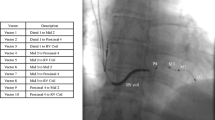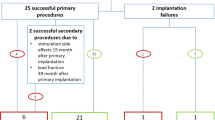Abstract
Background
Phrenic nerve stimulation (PNS) occurs at follow-up in approximately 20% of patients with bipolar leads. The quadripolar Quartet model 1458Q (St. Jude Medical, Sylmar, CA, USA) left ventricular lead (LV) has four electrodes (one distal tip and three ring) capable of ten different pacing vectors which may allow reprogramming to eliminate PNS.
Methods
Forty patients underwent attempted CRT-D implantation between October 2009 and October 2010 with the Quartet lead. Pacing parameters, lead position, complications and presence of PNS were collected at implant, pre-discharge and at 3 and 6 months follow-up.
Results
A quadripolar LV lead was successfully implanted in 95% (38/40) of patients. During follow-up, one patient (3%) had a lead displacement requiring reposition. LV pacing parameters remained stable at 6 months follow-up (mean threshold 1.3 V at 0.6 ms and impedance 948 Ω). PNS at the time of implant was observed in 12 patients (32%) all of which were overcome by using the additional vectors available on the quadripolar LV lead or by repositioning the lead at the time of index implant. During 6 months follow-up there were five (13%) cases of PNS, all of which were successfully treated by reprogramming to a different vector. No cases required reintervention, surgical epicardial lead placement, or that lead be turned off.
Conclusion
The quadripolar Quartet lead is associated with a high implant success rate, stable pacing parameters and a low displacement rate during the first 6 months after implant. The ten LV pacing vectors available with this lead allowed PNS and capture threshold problems to be overcome at implant, and importantly at follow-up, thus obviating the need for lead reposition.




Similar content being viewed by others
References
Levy, D., Kenchaiah, S., Larson, M. G., Benjamin, E. J., Kupka, M. J., Ho, K. K., et al. (2002). Long-term trends in the incidence of and survival with heart failure. The New England Journal of Medicine, 347(18), 1397–1402.
Mehta, P. A., Dubrey, S. W., McIntyre, H. F., Walker, D. M., Hardman, S. M., Sutton, G. C., et al. (2009). Improving survival in the six months after diagnosis of heart failure in the past decade: Population-based data from the UK. Heart, Jul 8.
Cleland, J. G., Daubert, J. C., Erdmann, E., Freemantle, N., Gras, D., Kappenberger, L., et al. (2005). The effect of cardiac resynchronization on morbidity and mortality in heart failure. The New England Journal of Medicine, 352(15), 1539–1549.
Bristow, M. R., Saxon, L. A., Boehmer, J., Krueger, S., Kass, D. A., De Marco, T., et al. (2004). Cardiac-resynchronization therapy with or without an implantable defibrillator in advanced chronic heart failure. The New England Journal of Medicine, 350(21), 2140–2150.
Abraham, W. T., Fisher, W. G., Smith, A. L., et al. (2002). Cardiac resynchronization in chronic heart failure. The New England Journal of Medicine, 346, 1845–1853.
Moss, A. J., Hall, W. J., Cannom, D. S., Klein, H., Brown, M. W., Daubert, J. P., et al. (2009). Cardiac-resynchronization therapy for the prevention of heart-failure events. The New England Journal of Medicine, 361(14), 1329–1338.
Biffi, M., Moschini, C., Bertini, M., Saporito, D., Ziacchi, M., Diemberger, I., et al. (2009). Phrenic stimulation: a challenge for cardiac resynchronization therapy. Circulation. Arrhythmia and Electrophysiology, 2(4), 402–410.
Bisch, L., Da, C. A., Dauphinot, V., Romeyer-Bouchard, C., Khris, L., M’baye, A., et al. (2010). Predictive factors of difficult implantation procedure in cardiac resynchronization therapy. Europace, 12(8), 1141–1148.
Dickstein, K., Cohen-Solal, A., Filippatos, G., McMurray, J. J., Ponikowski, P., Poole-Wilson, P. A., et al. (2008). ESC Guidelines for the diagnosis and treatment of acute and chronic heart failure 2008: the Task Force for the Diagnosis and Treatment of Acute and Chronic Heart Failure 2008 of the European Society of Cardiology. Developed in collaboration with the Heart Failure Association of the ESC (HFA) and endorsed by the European Society of Intensive Care Medicine (ESICM). European Heart Journal, 29(19), 2388–2442.
Dickstein, K., Vardas, P. E., Auricchio, A., Daubert, J. C., Linde, C., McMurray, J., et al. (2010). Focused Update of ESC Guidelines on device therapy in heart failure: an update of the 2008 ESC Guidelines for the diagnosis and treatment of acute and chronic heart failure and the 2007 ESC Guidelines for cardiac and resynchronization therapy. Developed with the special contribution of the Heart Failure Association and the European Heart Rhythm Association. European Heart Journal, 31(21), 2677–2687.
Shetty, A. K., Duckett, S. G., Bostock, J., Roy, D., Ginks, M., Hamid, S., et al. (2011). Initial single-center experience of a quadripolar pacing lead for cardiac resynchronization therapy. Pacing and Clinical Electrophysiology, 34(4), 484–489.
Shetty, A. K., Duckett, S. G., Bostock, J., Rosenthal, E., Rinaldi, C. A. (2011). Use of a quadripolar left ventricular lead to achieve successful implantation in patients with previous failed attempts at cardiac resynchronization therapy. Europace, Feb 22.
Burger, H., Schwarz, T., Ehrlich, W., Sperzel, J., Kloevekorn, W. P., & Ziegelhoeffer, T. (2011). New generation of transvenous left ventricular leads—first experience with implantation of multipolar left ventricular leads. Experimental and Clinical Cardiology, 16(1), 23–26.
Forleo, G. B., la Rocca, D. G., Papavasileiou, L. P., Molfetta, A. D., Santini, L., & Romeo, F. (2011). Left ventricular pacing with a new quadripolar transvenous lead for CRT: early results of a prospective comparison with conventional implant outcomes. Heart Rhythm, 8(1), 31–37.
Singh, J. P., Klein, H. U., Huang, D. T., Reek, S., Kuniss, M., Quesada, A., et al. (2011). Left ventricular lead position and clinical outcome in the multicenter automatic defibrillator implantation trial-cardiac resynchronization therapy (MADIT-CRT) trial. Circulation, 123(11), 1159–1166.
Conflicts of interest
A.K. Shetty is supported by an educational grant from St Jude Medical. C.A. Rinaldi has received research funding from St Jude Medical and Medtronic and has consultancy agreements with St Jude Medical, Medtronic, Boston Scientific and Spectranetics.
Author information
Authors and Affiliations
Corresponding author
Rights and permissions
About this article
Cite this article
Mehta, P.A., Shetty, A.K., Squirrel, M. et al. Elimination of phrenic nerve stimulation occurring during CRT. J Interv Card Electrophysiol 33, 43–49 (2012). https://doi.org/10.1007/s10840-011-9598-5
Received:
Accepted:
Published:
Issue Date:
DOI: https://doi.org/10.1007/s10840-011-9598-5




